Are your pepper plants not growing as expected? Slow or stunted growth happens to peppers sometimes, but there are methods to fix it. We have put together our top tips for when your pepper plants are not growing.
The first few tips in this article will pertain to younger plants, while the later tips apply to more mature pepper plants. However, we recommend reading all of these causes to ensure that you take preventative measures next season!
All of these methods are part of basic pepper plant care. Your routine may simply need one adjustment to get your pepper plants to start growing normally again. For each possible cause, we’ll cover some other symptoms you will likely see in addition to slowed or stopped plant growth.
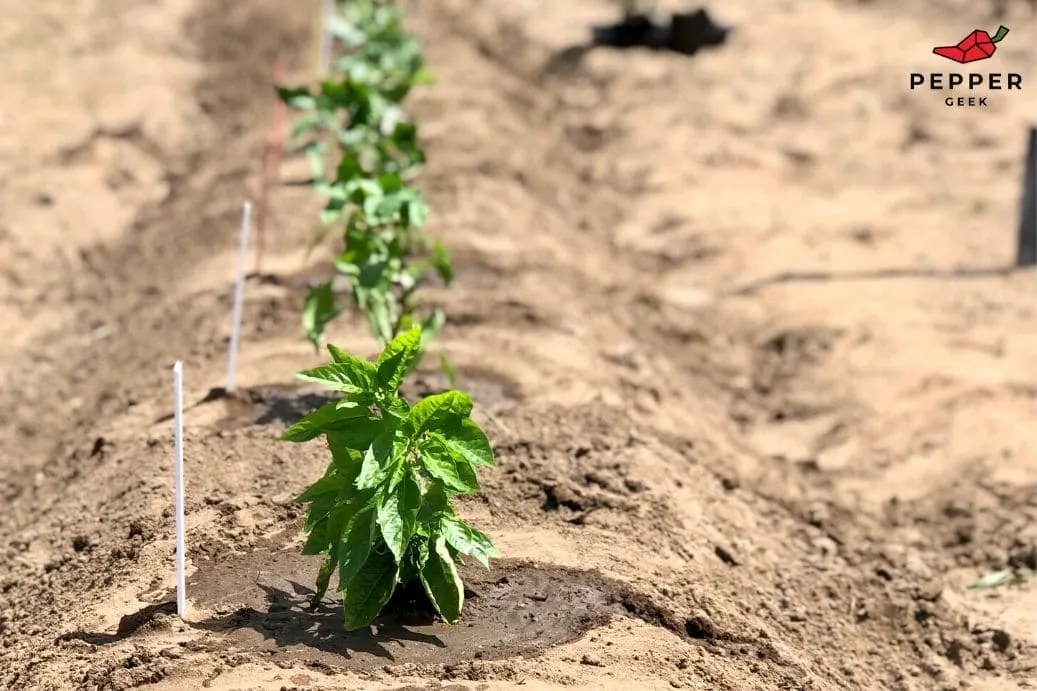
1. Give Young Peppers Plenty Of Light
Peppers come from a warm climate with lots of sunshine. Young plants are the most susceptible to poor growth if given too little light.
No, a sunny window is not ideal for young pepper plants. For best results and the fastest growth, use a grow light on seedlings indoors. We recommend to provide young pepper plants with 14-16 hours of light per day.
Symptoms of poor lighting:
- Leggy plants (tall and lanky)
- Thin stems
- Slowed growth rate
If you already use a grow light, make sure it is strong enough for your peppers. Light is the energy source for your plants, and this energy is used to form new leaves and branches. Without adequate energy, your pepper plants will grow more slowly.
For a quick recommendation, try this budget grow light on Amazon.
2. Fertilize Regularly (But Not Too Much)
Once pepper seeds sprout, they will start to use nutrients. They don’t need much at first, but as they grow larger, they will use more and more.
Depending on the stage of growth, the type and quantity of fertilizer you use will vary. For young plants 4 weeks or younger, we recommend 1/2 strength nitrogen-rich fertilizer. Alternatively, you could use a nutrient-rich potting soil without fertilizing at all.
See all our recommended soils and fertilizers here.
For plants that are beginning to produce flowers and fruits, we recommend switching to a phosphorus-rich fertilizer and reducing nitrogen. This encourages the plant to stop growing new leaves and focus on producing peppers.
Other symptoms of nutrient issues:
- Yellowing leaves
- Leaves wilting or falling off
- Flowers dropping
Note: If you use a nutrient-rich soil, then fertilizer is likely unnecessary for the first 2-3 months of growth.
If your pepper plants are not growing, consider your fertilizer regimen and adjust if necessary. If you are fertilizing consistently or have healthy soil, look to other possible causes.
3. Remove Early Flowers and Peppers
One of the most common causes of smaller peppers is leaving early fruits to form. During the first few weeks of outdoor growth, you should pick off flowers and fruits.
This helps the plant direct more energy into growing roots, branches, and foliage. The early growth translates to a larger harvest later in the season.
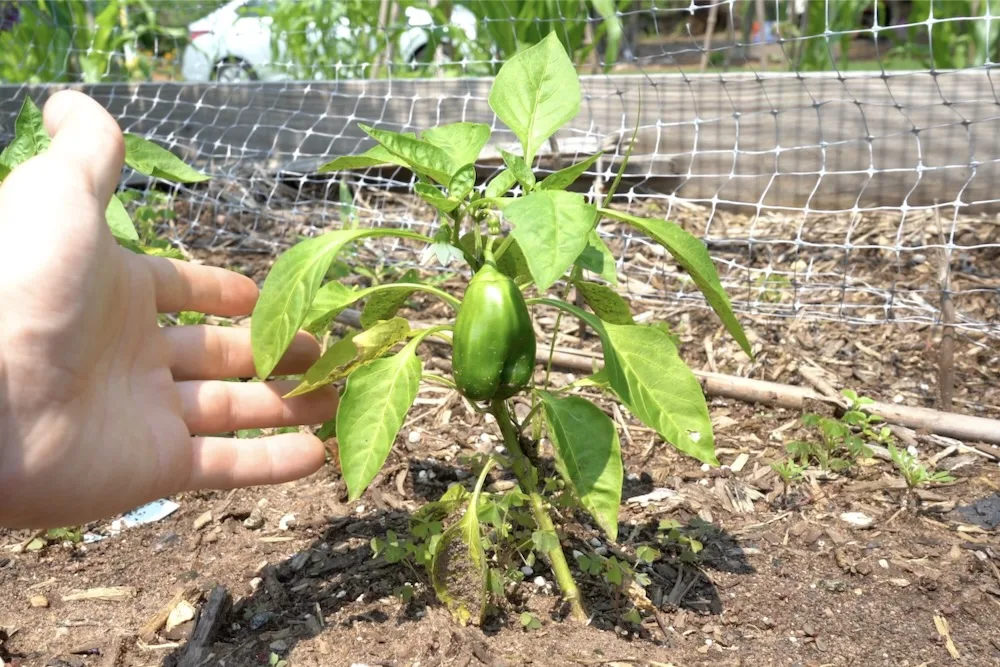
It can be tempting to leave an early bell pepper on your plants for a quick harvest. However, this will only set your plants back and cause them to perform poorly overall.
We typically recommend picking any flowers or young fruits until the plants have been outside in their permanent location for 2-3 weeks. After that, leave the flowers on to grow and produce fruits!
4. Transplant Shock
Transplanting is a necessary step in growing peppers from seed. Shortly after transplanting seedlings into larger pots or into the ground, the plants may grow more slowly for several weeks.
This is normal. When peppers move to a larger body of soil, the root systems need some time to adjust and grow into the new surroundings. Be patient and allow the plant to recover and establish itself without too much disturbance. We also recommend avoiding fertilizing for the first 1-2 weeks after transplanting.
Sun shock is a related issue that can occur when transplanting peppers to the outdoors for the first time. Direct sunlight is much more intense than grow lights, and pepper plants must be hardened off gradually to avoid damage.
Other signs of transplant shock:
- Leaf drop
- Curling or abnormal leaves forming
- Sun scald (if moving to the outdoors)
Most important is to be patient after transplanting while the plant gets established. More often than not, the plants integrate within a couple weeks or so, and then take off in growth!
Note: If your plants have been outdoors for several weeks and are still not growing, your soil may be compacted. Avoid walking on garden soil, especially when it is wet!
5. Don’t Compress Soil Too Much
The roots of your pepper plants like a well-aerated, porous medium to grow through. If you pack your soil too tightly, the roots may struggle to access oxygen. Water may also have difficulty draining properly from the soil.
For potted plants, we recommend packing soil down somewhat, but never too tightly. When filling new pots with soil, stop compressing when you start to some feel resistance. This is especially important if you are using a coir-based product.
Compress too little, and the soil will collapse when you water for the first time. Compress too firmly, and the roots may not have access to enough oxygen.
Other signs of compacted soil:
- Root rot
- Leaves dying
- Oversaturated soil
- Poor drainage
If your ground soil is compacted, use a garden fork to gently loosen the soil up. For raised beds or garden plots, we recommend gently loosening (not tilling) the soil each year a few weeks before planting.
Also, add compost and other organic material to ground soil to encourage good bacteria! Compost also helps with drainage and soil structure over the long term.
6. Transplant To A Larger Pot
One of the most obvious causes for pepper plants not growing is an under-sized container. Many pepper varieties can grow to be very large, over 6 feet in height. However, this is only possible with enough soil space.
We generally recommend that peppers are grown in a minimum of 3 gallons of soil. Ideally, your final pot size should be 5 gallons or larger for maximum yields.
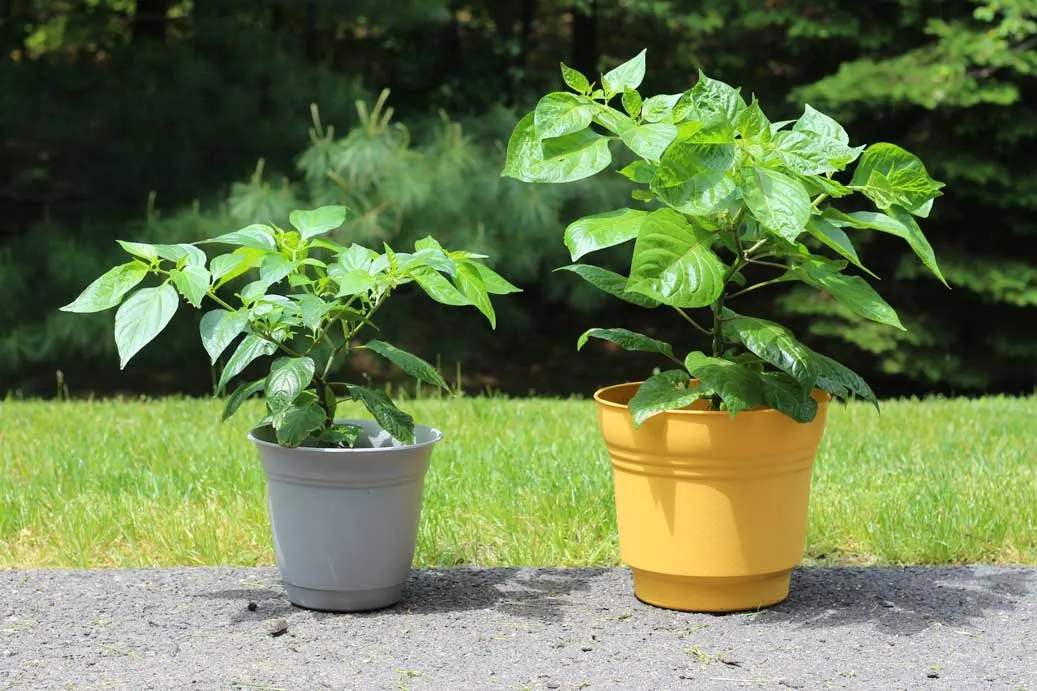
Other signs of under-sized containers:
- Plants begin flowering early
- Root bound plants
When transplanting pepper plants, the timing is most important. Seedlings in small seed cell trays should usually be upsized to 3-4″ pots about 2-3 weeks after sprouting. After another 4-6 weeks, they will be ready to move outdoors to full-sized containers or into the ground.
7. Pull Weeds Regularly
This may seem obvious, but weeds can inhibit your pepper plant’s ability to grow. While weeding is a chore, it is important to avoid your peppers from competing with unwanted plants. Weeds can also be a breeding ground for unwanted pests.
Pull weeds when they are small to prevent large, nutrient-stealing root systems. Alternatively, lay down a mulch cover around the base of your peppers, such as chopped straw or a black tarp. This will prevent weeds from growing in the first place.
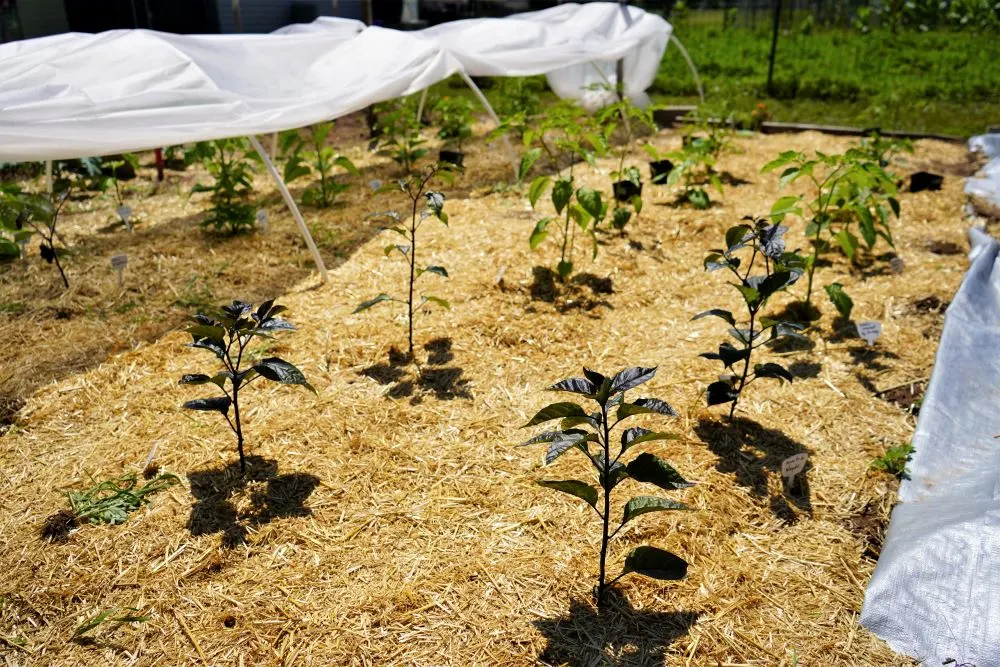
Learn more about keeping weeds out of the garden here.
Other signs of excessive weeds:
- Well, when the weeds are taller than your pepper plants, you have a problem!
For larger garden plots, we highly recommend using a weeding hoe.
8. Check For Pests
Pests can be a nightmare for any type of garden plant. Peppers are vulnerable to aphids, spider mites, thrips, grasshoppers, slugs, caterpillars, and many others.
When pepper plants are under attack, they can often slow or stop growing. However, there are some tell-tale signs of insect damage.
Other signs of pest damage:
- Curled leaves
- Holes in leaves or peppers
- Random brown spotting on leaves
- Bite marks in leaves (usually caterpillars or slugs)
- Live pests (look closely and under leaves)
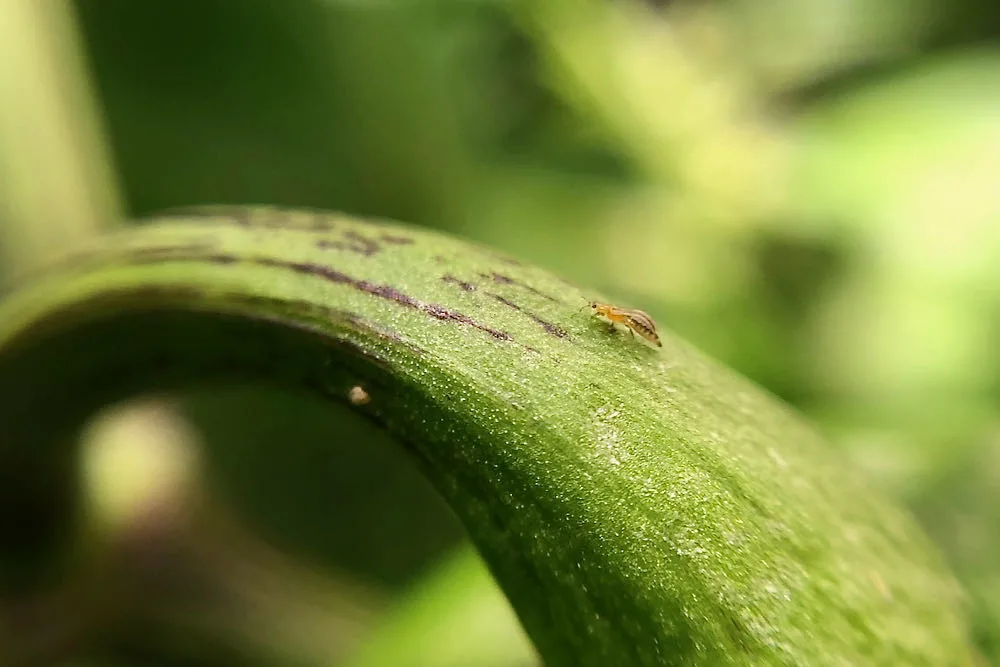
Aphids are known to feed on young foliage. If you have aphids, your plants may be trying to grow, but can’t because the new leaves are being destroyed.
Learn more about treating pests on pepper plants in our article here.
9. Disease
Unfortunately, pepper plants are susceptible to a variety of diseases as well as pests. Most will cause visible signs of infection and distress.
Diseases can often mean that your pepper plant must be discarded. Most can spread easily from one plant to another, and many can lay dormant in soil or seeds, infecting future crops.
To avoid disease, always be sanitary while in the garden. We also recommend bottom pruning pepper branches to keep leaves up and away from the soil. Never water over the top of your plants, always just at the base of the main stem.
Many diseases are spread via pests as well, so be sure to control your pests in addition to bottom pruning and mulching. Read our article on pepper plant diseases and problems here.
10. Plants Have Reached Mature Size
The last possibility is that your pepper plants have simply reached their mature size! Some pepper varieties won’t grow above 1′ tall, regardless of container size. Others can grow to be truly massive and produce thousands of pods.
Be sure to set your plant size expectations realistically at the beginning of the grow season. In our experience, C. chinense and C. baccatum pepper species tend to grow quite large, while C. annuum are small to medium-sized.
As we’ve covered, there are many possible causes for pepper plants not growing or growing slowly. With the right nudge, I hope your plants will be back on track and growing healthy again soon.


Vince
Monday 15th of April 2024
My pepper seedlings all sprouted about three weeks ago, but they are not really growing at all. Most of them only have one set of true leaves, but the true leaves are only about 1/4”-1/2” in length. The plants are all about an inch tall and haven’t increased in height either. I grew them in seed starter mix, but I’ve been adding 1/2 strength miracle gro fertilizer once per week since they sprouted with no change at all in growth. They’re under a mars hydro 300w light (25% at 12” away) and PPFD ranges from 170-250 from the outer edge to the center for all of the plants. Is it because I used a nutrient-less seed starter? Should I just re-pot everything in potting soil? Thanks!
peppergeek
Wednesday 17th of April 2024
Hm, how is the temperature in the growing area? I'm not sure what might be causing this sort of setback in a well-lit area other than cold, or maybe pH. If you're using tap water maybe test for pH to see if it is highly alkaline, and adjust to acidify to around pH 6.5. I wouldn't overdo it on the nutrients, what you're doing sounds a-okay.
Bobby
Sunday 29th of October 2023
My bell peppers are fully grown but some of them are staying small they are not getting very big the fruit
peppergeek
Tuesday 31st of October 2023
Try this article: https://peppergeek.com/why-are-peppers-small
Basil Stavrakis
Sunday 3rd of September 2023
My pepper plants look good, but no blooming, what’s wrong?
Carri
Wednesday 27th of September 2023
@Basil Stavrakis, I live in Texas where it's been very hot. My pepper plants would not flower in extreme heat 100+F. But now that the temps have dropped a bit, they are flowering. Not sure where you live, but temperature can be a factor.
Tom C
Monday 12th of June 2023
Soo I did my first overwinter of pepper plants. 2 survived, and after putting them in the garden early May. Only one of them has sprouted leaves. The second has yet to do anything, its alive and has nice green stalks but no leaves yet with a full month outside. I'm wondering why that is? I don't know the types of either one but I'm guessing it's because it's a hotter variety and needs constant high temperatures? But I'm just guessing. Wondering if you know why or have had this happen before as well?
peppergeek
Friday 22nd of December 2023
Curious if your plant ever sprang back to life? It sounds like it may have died due to the trauma
donald boots
Sunday 4th of June 2023
i’ve got no problems so far. just aphids june 1 in pittsburgh pa. got a bell pepper 4 inches first of the new year. still green i over wintered plant in garage ha ha